2015 Honda CRF250R
Fork Over Some More Power?
MSRP: $7599.00
- A "complete package" bike without standout characteristics or any real faults.
- The smooth and fast motor makes lap times come down.
- One of the most tunable engine, suspension and handling packages we have ever seen but most riders shouldn't need to mess with it.
- Smooth power is often confused with being slow, not so.
- Having to check fork air pressure (and having to buy the right tool/pump) may be crossing the line for some.
- We feel Honda could have done better with the option 2 and 3 maps.
- Pump for air forks sold separately!
Introduction
- 2015 is a minor update year but a big change to an air fork.
Last year, 2014, was the big change year for the CRF250R. It received an all-new chassis that is identical to its big brother CRF450R save for some fitment issues with the smaller engine and some big updates to the engine to boost the power and the engine character. The frame change was a welcomed and praised update, the engine was still, for most, a little lackluster in character. To some it was even called slow. Honda feels differently but for 2015 gave the CRF250R a shot in the engine with a switchable ignition/fuel capability and the big change to a Showa Triple Air Chamber Single Side Function Air Spring Fork. In a class where power seems to be everything, at least in test comparisons, where does that put the Honda?
Changes
- Showa TAC SSF Air fork.
- Three ECU maps switchable by pushing a button.
- Larger 260mm front brake disc.
Truthfully the biggest change to the CRF is the SSF Air fork. Now 49mm, up from 48mm, it is technology that was until very recently a work suspension-only feature. Honda has it’s own proprietary design to the system with the air spring on the brake side of the bike and all of the damping duty on the right side leg of the fork. The objective here is simplicity with only two pressures to be concerned with, the safety not having an additional chamber externally mounted where it could be damaged and lose pressure affecting performance and finally they feel the weight distribution is better balanced with the lighter fork leg now on the same side as the heavier brake components. Additionally even though there are three chambers in the air fork, Honda chose to use only two of the chambers to hold pressure (though the third outer chamber could hold pressure if you wanted) with the balance chamber housed entirely inside the fork. It is claimed to be just under three pounds lighter adding weight savings as its main feature. Every other aspect of the chassis and frame remain unchanged except for valving changes to the Showa rear shock to match the new front fork. The rear spring rate is claimed to be the same, just a new color.
Next on the list is the updated programming to the ECU for fuel and ignition settings. Additionally the CRF250R comes with a handlebar-mounted button to allow you to switch between three pre-programed maps. You can alter the settings of the second and third maps in the ECU with the HRC Setting Tool and switch them with the push of a button. There is also a change to the outlet diameter of the mufflers that is claimed to boost power as well.
The front brake goes up in diameter from a 240mm disc to a 260mm rotor to improve brake power and feel. There is a new larger cover over the front brake as well. Some styling tweaks of blacked-out accents, like radiator guards and rear brake protection pieces give the CRF a fresh look.
Power
- Small changes boost the quickness of revs but not much in overall power.
- For a 250F the power is smooth and linear and has little sign-off before hitting the rev limiter.
- Though the pre-programed stock maps have small changes between them, you can really do work with the HRC tuning tool.
The biggest change for the engine on the CRF250R is that it now starts easier. OK, the map switch capability is really the biggest change, but starting is improved. In 2014 the bike acted lean when starting and now it boots to life effortlessly. Then the engine character is very similar to last year with a very smooth, controllable and linear build of power that never hits and runs straight into the rev limiter without a hesitation or a taper. It is very characteristic of the style of power Honda tunes into most of its engines-- it feels slower and less exciting than some others out there. To combat this feeling Honda even lightened up the throttle pull spring tension and opened up the dual mufflers a little bit. This increases the sound and flow yielding a slightly quicker-revving feeling especially on the bottom. This character continues through the power spread, but only in the slightest amounts. And despite what it feels like the bike is not slow or underpowered. We did a lot of back-to-back testing with other 250Fs to be absolutely positive. This power just moves the motorcycle without flash or fanfare.
As a rider you can chose between three maps through the push of a button right next to the throttle. The first map (one blink) is always standard or stock and cannot be altered. Maps 2 (two blinks) and 3 (three blinks) can be used by holding the button down for one second with the RPM down at idle and can also be modified by using the HRC Tuning Tool. It is nearly impossible to switch while riding as you have to have the clutch in to let the RPM drop enough for the button to switch, obviously lawyers were involved and Honda prefers and recommends you pull off the track and do this in a safe location. Then during daylight hours it is difficult to see how many times the blue colored illuminated button blinks to make sure you made the change. And contrary to what other magazines have said, you can only switch one map step at a time, not jump from 1 to three with a longer button push. It is a great feature for switching maps and fun to play with if you don’t need to do it on the fly. Map 2 is Honda’s less aggressive map and it is not that noticeable of a change from standard really, especially on the top end where it is virtually identical to Map 1. Map 3 is the aggressive map and it isn't that much of a change from standard either, but it was enough that most every rider preferred it over standard as it is a little more snappy.
But all of the standard maps have one issue that some liked and others didn’t. The CRF runs through the top-end power very quick and is easy to get into the rev limiter. There isn't really any over-rev, more of a rev-limiter induced sign-off. Especially when there isn't much of a load on the engine or the wheel is in the air or spinning freely. Luckily we have the HRC tuning tool and it was just a matter of clicks and a plug-in to the bike to alter Maps 2 and 3 to sort this out. We found the standard maps were all a little lean, especially on the top end at big throttle openings so we added fuel. This slowed down how quick the bike spun up and made it feel like there was more useable power on the top-end. We found that at our tracks, between sea level and 3000 ft. the CRF liked between 2-4% more fuel to let the upper power work longer. Ignition timing did not have as much effect as it does on a 450 and this CRF did not respond well to advancing at all. In fact we were retarding it a bit in the upper RPMs to get more response which is backwards from convention. Even Honda’s own aggressive map does this on some sectors. If you have the HRC tool and would like to see or test our maps, let us know, it is an email away.
The HRC tool is a very advantage tuning option that savvy riders will take advantage of. It can really liven up the standard power delivery and is really a necessity if other engine modifications are planned to make them work to their potential. It is jetting for the modern era, no spilt gas either.
The clutch and transmission are top quality with shifting that is excellent. Clutch lever pull is light and the control and modulation is excellent. But if you abuse the clutch, the Honda is not the most durable unit, likely do to the lighter springs. It only takes a few times going through turns two gears high to feel the fade kick in. The control is so good you can do this, but not for long. The twin mufflers are described as a handling performance gain and we have felt it was a countermeasure to increasing sound regulations. It is extra parts and extra weight but we know some really prefer the look more than anything.
Suspension
- The Showa/Honda air fork is really good without being really different than a spring fork in feel.
- Weight is a huge advantage but the tuning options are now multiplied for those who will use them.
- The best thing is that standard settings are excellent, most riders will not need to deviate much from there.
The new chassis through its suspension is even more picky or sensitive to setup than last year and a big leap from previous CRF250Rs. Ride height is extremely important (105mm is recommended) as is checking the pressure in the fork chambers before each ride. Though ours fork pressure never changed (or leaked) in the few weeks we had the bike, it is like tire pressure, you need to check it to be sure. And with a big change to an air fork and specifically this Showa TAC SSF Air system, you have to remember that air pressure is the spring rate and damping is still handled through the oil cartridge with the clickers on the right fork leg. Don’t get all confused, riders were not changing spring rates every time they went to the track but now since it is a possibility they get all confused with pressures forgetting about the standard settings. And lucky on this CRF the standard setting is excellent.
The SSF Air actually acts less like an air fork than any other air fork. It has one very awkward characteristic of acting like the fork has a lot of stiction, but despite what it feel like pushing it up and down in the shop, it does not act this way on the track. The overall feel of the suspension is stiff, a very motocross stance. The CRF holds itself up high in the stroke and gives the rider a true feel for the ground. The fork is not as initially plush as some other air forks we have ridden and truthfully mirrors the feel of last year’s spring fork on the initial part of the stroke, which is good. It then moved through the stroke more linearly than most air systems and ramps up with excellent bottoming resistance, especially for a 250F and quite well for larger and heavier riders. The rear shock is a perfect match in feel for this so the ride is balanced.
If there is a difference in how the fork performs in comparison to the traditional spring fork of last year, it is in the mid stroke where the air fork has a more “springy” nature. There seems to be a point where the progression ramps up substantially and here a bouncy feeling can occur when the load on the fork keeps the bike compressed here but not enough to go farther and get into the bottoming zone. The advantage comes on harder hits, ones that would crush the traditional fork into a metal-to-metal bottom. The air fork resists this much better and in fact is downright difficult to get a bottoming clank out of. And if you do there is still room to add oil to further reduce any bottoming issues, just as before. Showa and Honda have always had excellent bottoming resistance, now it is better.
We played with settings and for the most part came back to standard as the best setting for most riders. Faster riders liked a little more air in both chambers of the SSF Air fork and the clickers could easily tune for any small character changes. We found that one-click increments were easily noticeable. Ditto for the rear shock, Interesting is that now with the use of high-speed compression and spring preload on the rear shock and the balance air chamber on the bottom of the air spring fork leg, you can tune the ride height and the balance of the bike to whatever you want and totally change the character of the CRF. Standard setting is neutral with a bias to track on the front wheel and resist sliding the back much. One issue with the fork is that it is much easier to adjust the balance air pressure with the front brake disc cover removed to get your fingers spinning the pump in the Schrader valve.
Chassis - Handling
- The CRF is one of the lightest feeling bikes on the track.
- This Honda is very neutral handling and does just about everything well.
- Ergonomics fit a wide variety of shapes and sizes without the need to move or adjust much.
The CRF is a light feeling bike. Weighing in at 224 lb. empty and 236 lb. with a full tank. It also feels tight and sturdy. How much of this comes from mass centralization and things like the twin muffler, we’ll let a physicist tell you. The bike is thin and easy to move around on with a layout that suits all sizes of riders comfortably. The standard sized Renthal bars have a comfortable bend and levers and controls all fit right where they should be for most riders with enough adjustability, but nothing overboard. The seat is comfortable in the front but heavier riders can get through the very thin foam near the rear of the bike. We did not have any issues with hooking pants or boots on shrouds or on frame rails.
And as light as the CRF is it still remains quite stable, especially if the setup is tuned properly. There is the steering damper behind the front number plate, but that is really more of an aid in the turning department. It does not do much in a straight line. It works in limiting quick movements when the bars are turned, the farther they are from center the more the damper can react. Our experience is that it helps to keep the bike laid over in the turns especially when you get on the gas. We feel the setting is very light and most of our riders ran the damper in close to full-stiff. We wish the mid-setting adjustment were closer to here but out testing has shown that the damper works great when you don’t feel it and then when you do (too stiff) it really hampers the bike. Again Honda is playing it safe.
Tuning the handling character of the chassis in is easier than ever before. There are some pretty simple tools to get the bike to do whatever you want it to. Ride height setting through the rear shock can now be complimented with the balance spring on the fork, helping the fork (and the front of the bike) settle higher or lower in the stroke. Adding air pressure will lower the front of the bike as well as make the front feel softer. Less pressure in the balance spring has the opposite effect. We preferred the standard settings across the board, even with heavier riders. Our fast guys liked the front of the bike a little stiffer mostly for how fast they were hitting the jump faces, wanting the bike to stay up in the stroke here.
The overall biggest change to the handling character of the bike is the increased stiffness the larger diameter fork brings to the feeling. The millimeter increase in fork diameter really stiffens up the rigidity a rider’s hands and feet sense in the chassis. At first we suspected it was the new Dunlop MX52 tires, since Honda typically has their own proprietary softer and lighter standard tire, but not this year. So after switching to the Dunlop MX32 front and rear tires, expecting the softer terrain tire to aid in the bump compliance, the feel did not change. And since the fork is the only component on the chassis to change, it is a logical reason. Some riders liked a stiffer ride and others tried to tune it out through the clickers on the suspension with little improvement.
The bike is flickable in the air, more so that most every other motocross bike this side of a 125cc two-stroke. This makes placing the bike where you want it easy. The word precision handling comes to mind as the bike will go exactly where you want it to if it is set up correct.
Conclusion
- The CRF is know as a durable package for a racing 250cc four-stroke.
- It has a vanilla appeal to it. most people like vanilla even if it isn't their favorite flavor.
- The CRF made positive changes in the right direction but some may question, where they enough?
Rounding out the package is the new front brake that is definitely stronger and has plenty of feel, though we’d bet the rubber brake line is as much to blame for the downfall of the 240mm brake as anything. The line is still rubber and if you want a crazy strong front brake, try upgrading that. The rear brake is all it needs to be, strong and with good feel. Even the switch to the standard MX52 was well received as the tire performs well and wears long.
Working on the bike for routine maintenance is simple. The air filter is easier than a few years ago with more room to get it out from the top of the air box. Honda uses a separate chamber oil system in the engine and transmission to eliminate the spreading of oil contamination. So it is two drain plugs instead of one and filling two different compartments with different amounts (and sometimes different oils) that seems like a pain but it isn’t that much harder after you know the system. Doing valve maintenance on the Unicam motor is actually easier than typical DOHC systems and for sure checking the valves is simple. The durability of the engine is as good as can be expected from a racing 250F and the valve issues of early CRFs are long gone. Some have noticed that the frame discolors easier than in the past and the welds are not a perfect looking as they were in the heyday on the aluminum frame. Are the robot welders getting complacent and less perfect in their old age? We quickly put over 15-gallons of fuel through the bike and a couple of oil changes where everything looked great. Our only issue was with some slight bending of the radiators near the top outside from one of our tester’s knees and the visual damage knee braces and worn boots did to the clutch cover and the radiator shroud.
The 2015 CRF250R is a more aggressive bike than last year, by just a small step. As usual, the bike is very well packaged, consistent and potent motocrosser in a lot of ways a wolf in sheep’s clothing. It is the same CRF250R it has always been. At $7599.00 all of the bikes in this class are prices relatively the same, save for the European bikes that come with electric staring. And there is nothing about this bike in a performance sense to prohibit a rider from wanting to own a CRF. Now you could site specific characteristics all day long and the CRF’s lack of any one character, other than being a very solid and consistent package, may be its biggest downfall. There are others that feel faster, ride more angrily, snort, rip and bark differently, but they are not a Honda. Honda sticks to its guns and ways of doing things hoping and praying you understand this. Luckily the CRF250R represents this philosophy in a very positive light.
Recent Product Tests
What Others Said

http://www.motorcycle-usa.com/123/19008/Motorcycle-Article/2015-Honda-CRF250R-First-Ride.aspx

http://www.dirtrider.com/features/2015-honda-crf250r-first-impression/

http://www.cyclenews.com/329/24848/Racing-Article/First-Ride--2015-Honda-CRF250R.aspx

http://www.cycleworld.com/2014/07/28/2015-honda-crf250r-first-ride/

http://motocross.transworld.net/1000164737/news/first-impression-2015-honda-crf250r/

http://www.thumpertalk.com/topic/1104395-bike-review-of-my-2015-crf250r/
Rider Opinions
Leave a Reply
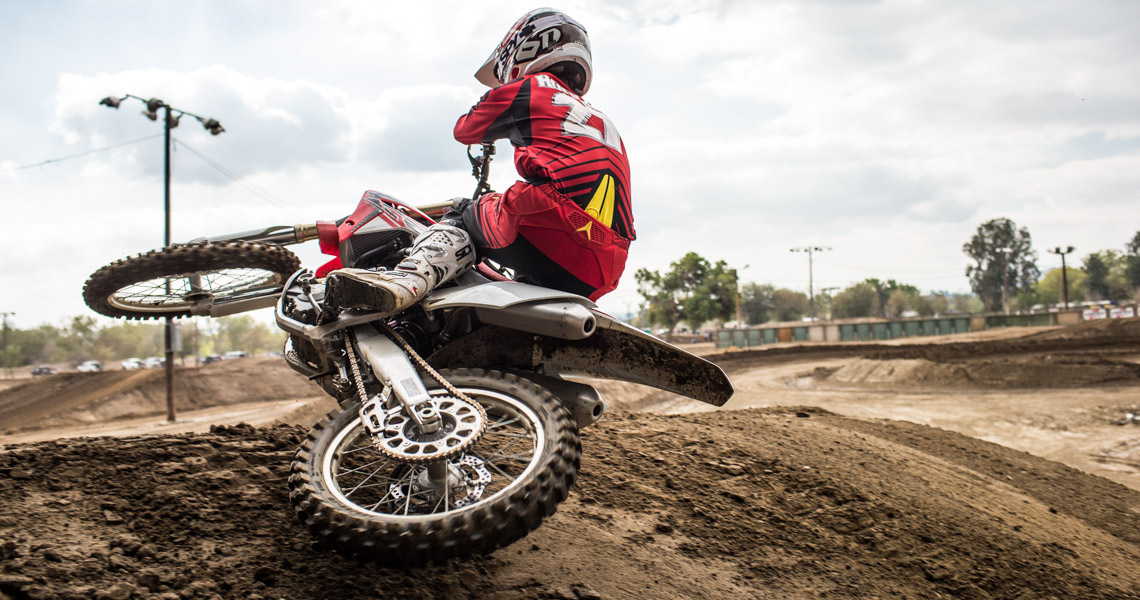
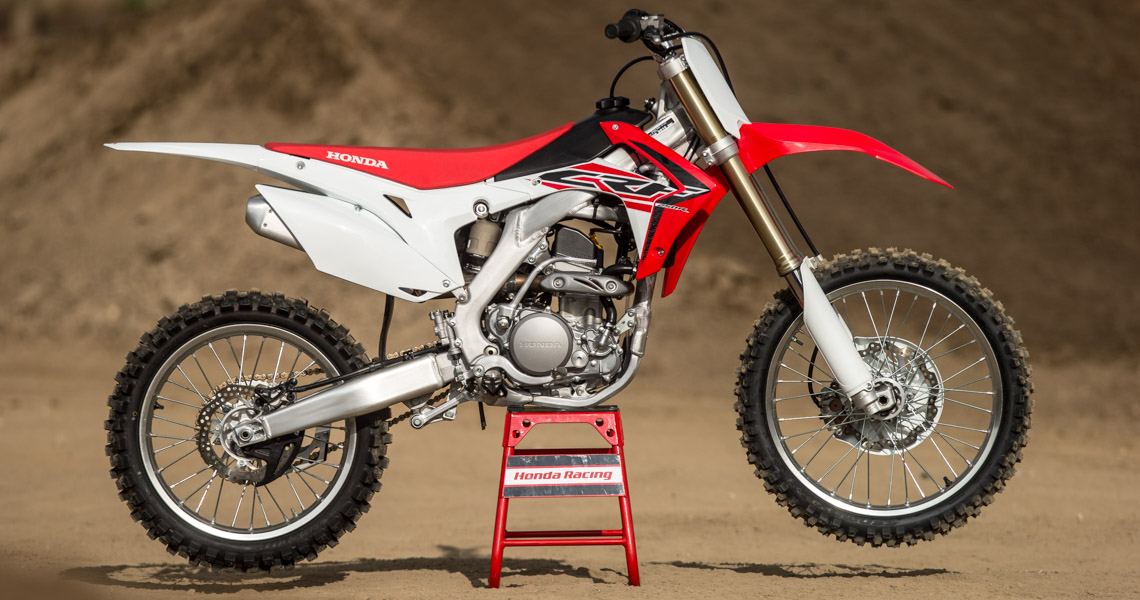
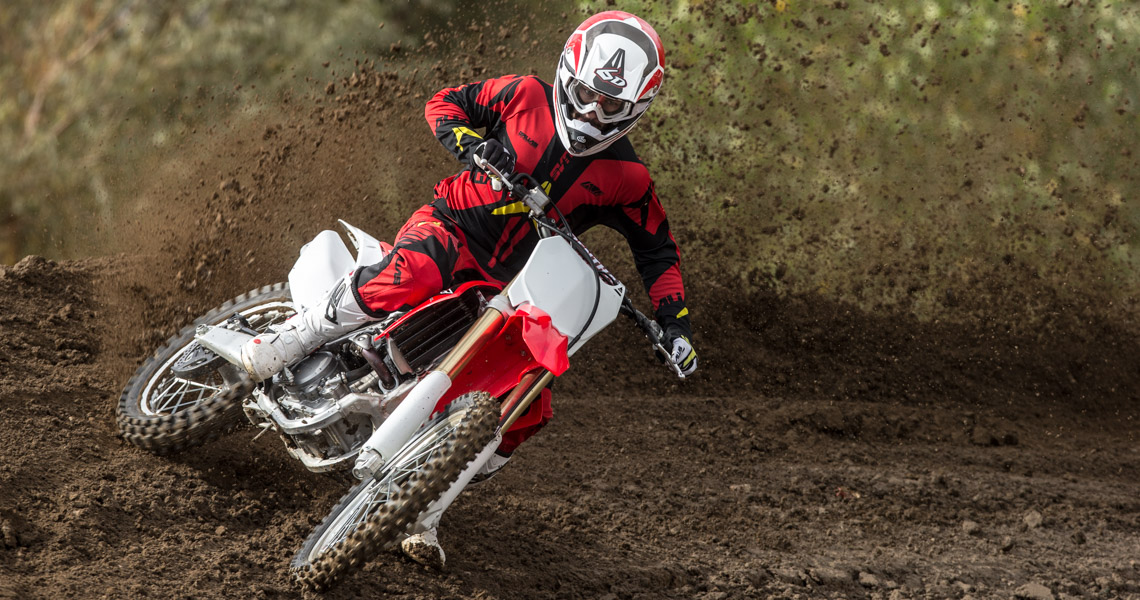

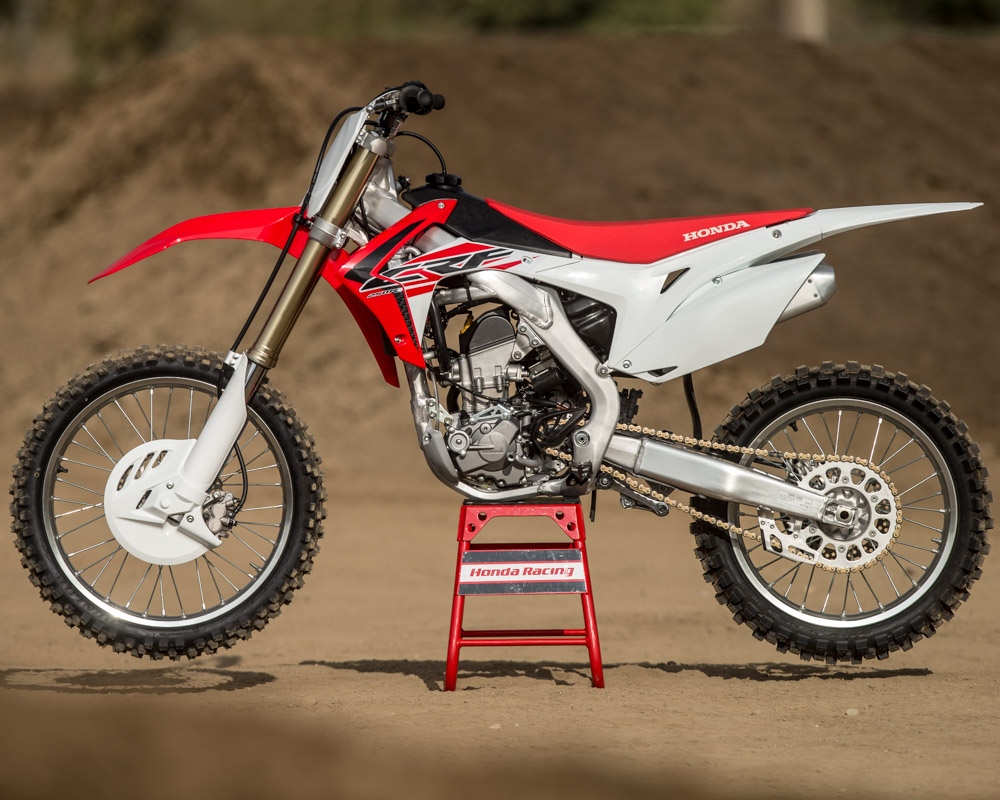
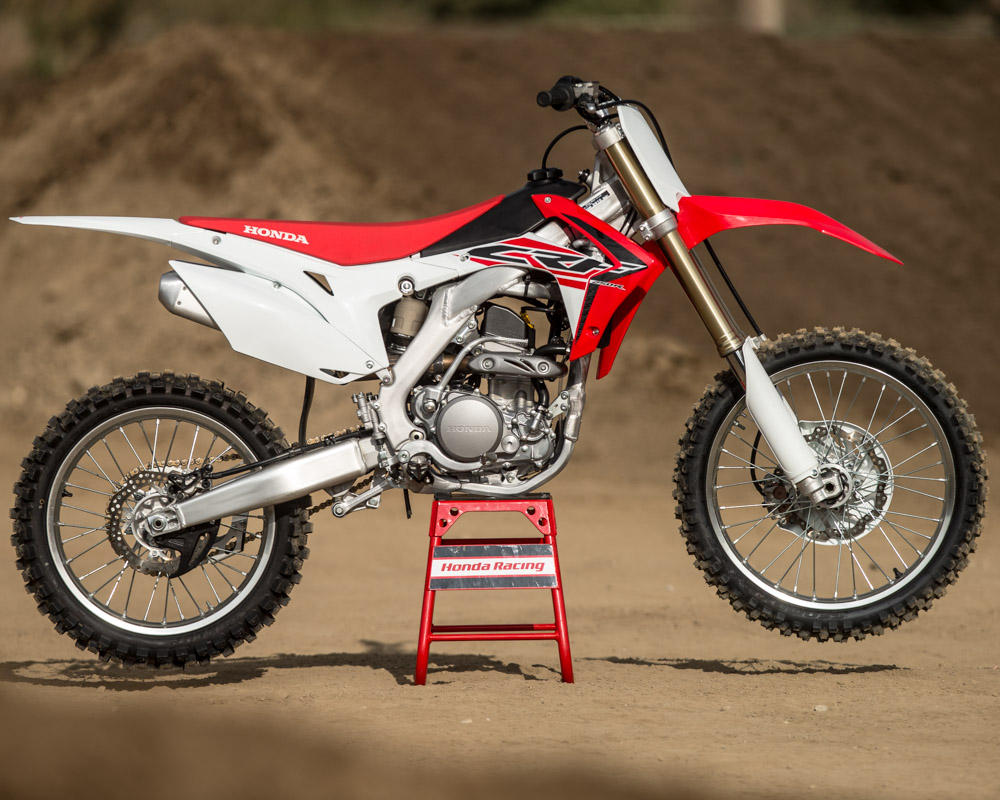
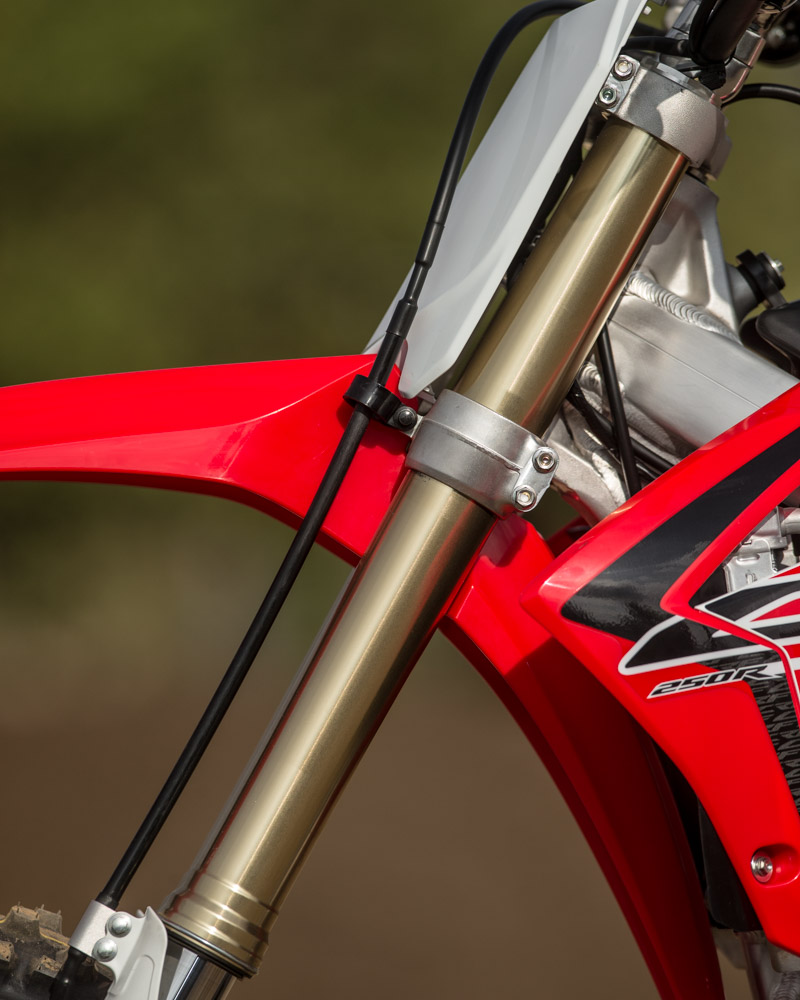


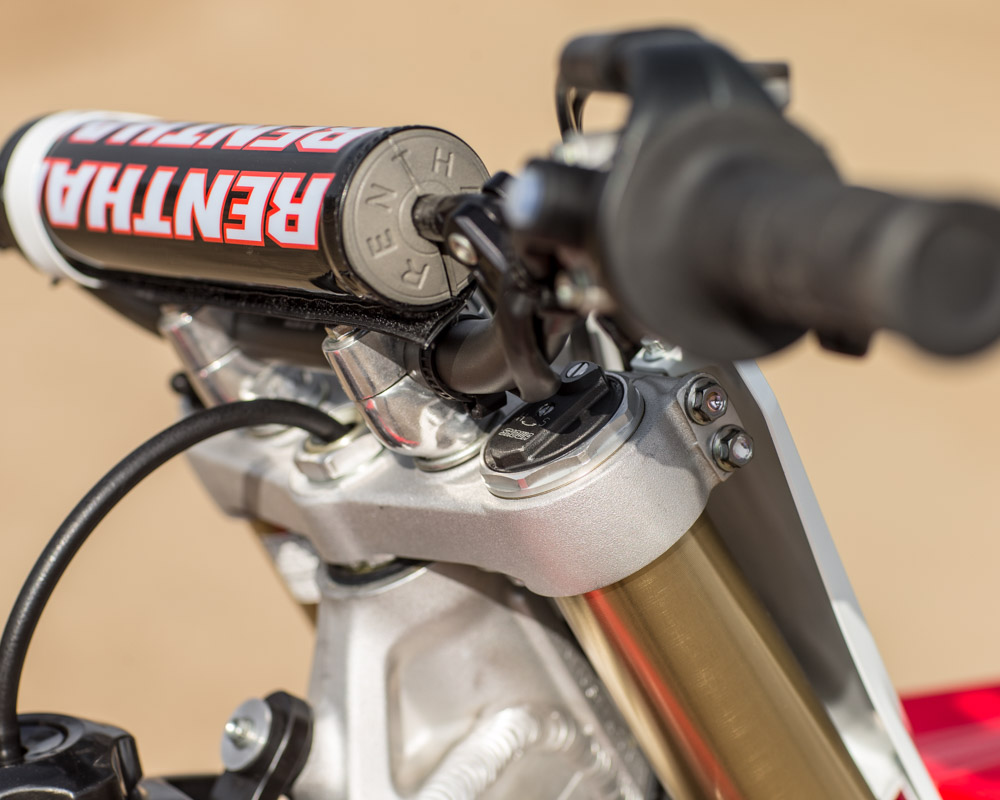
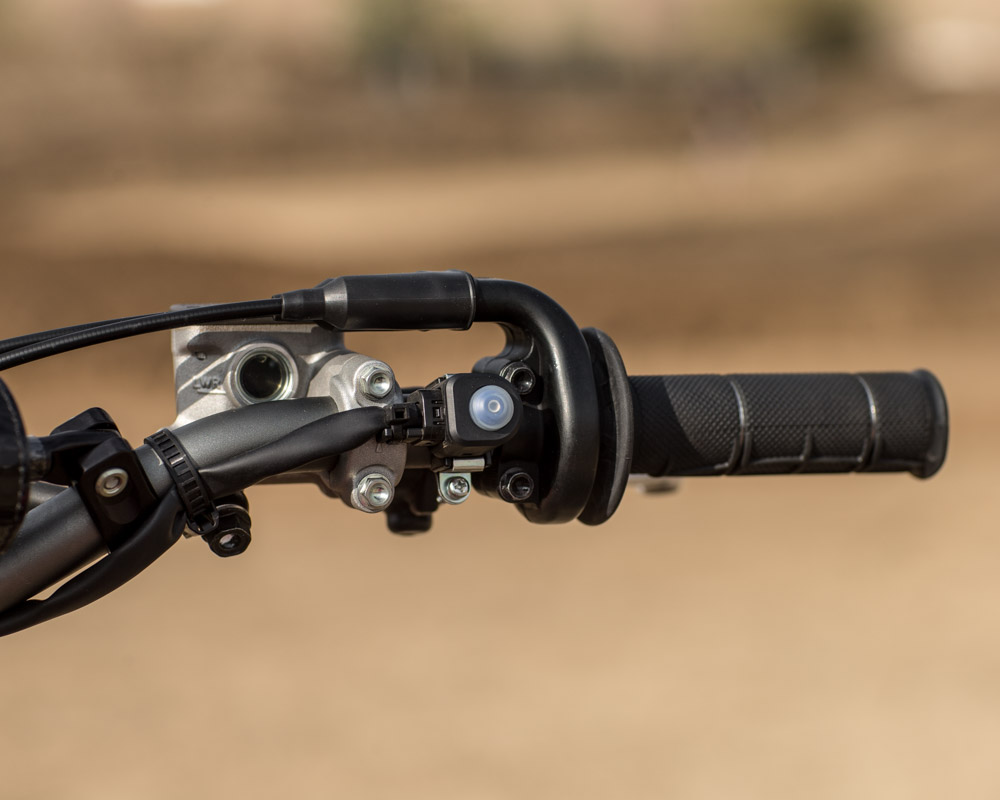
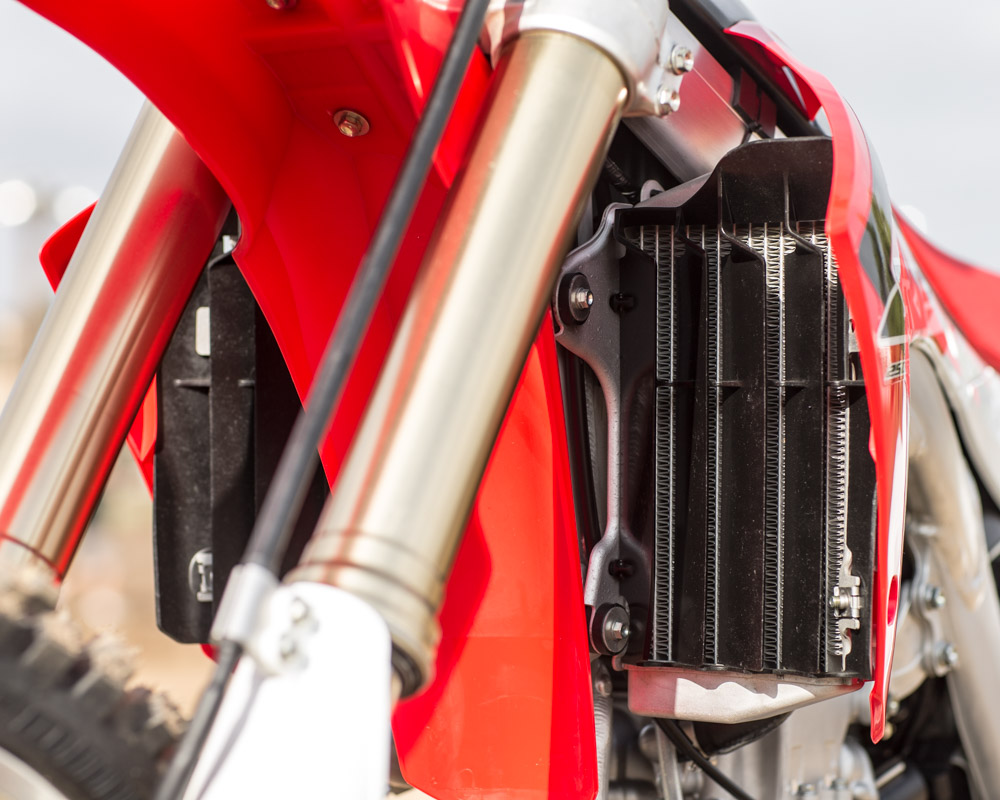
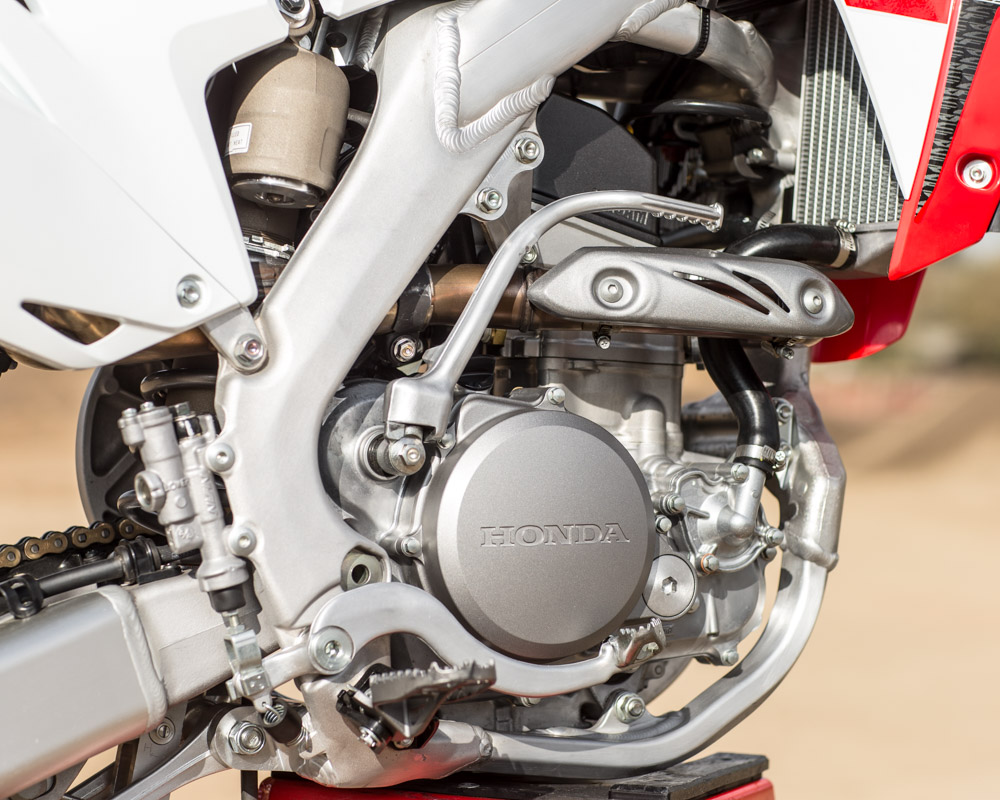
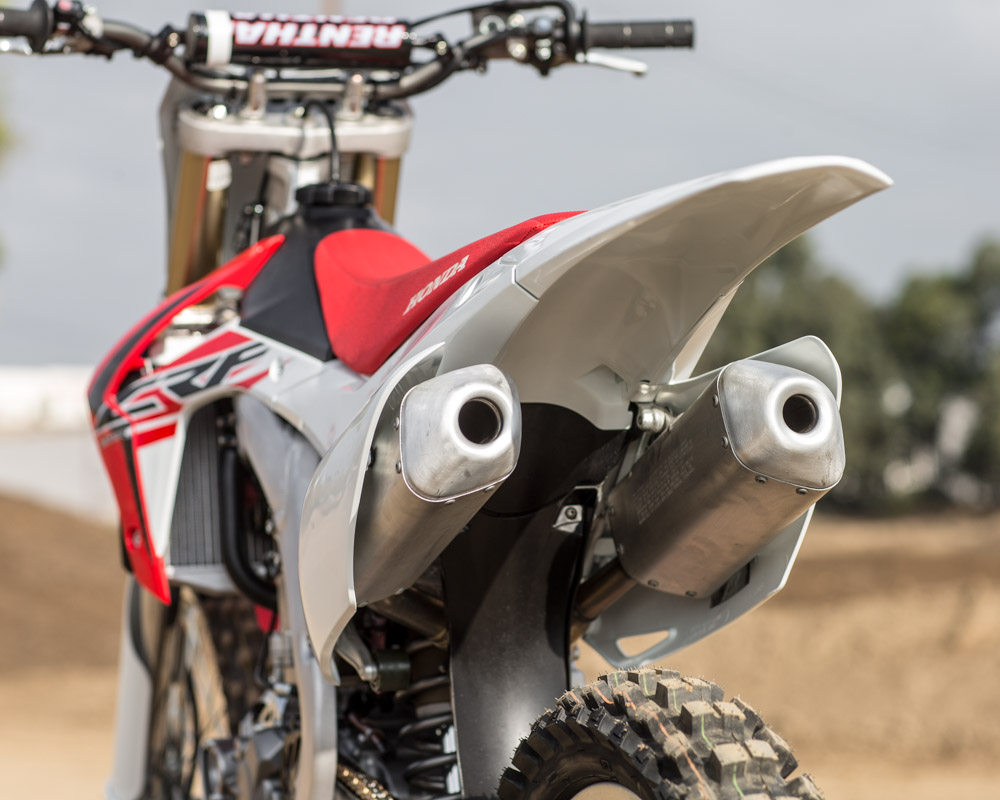

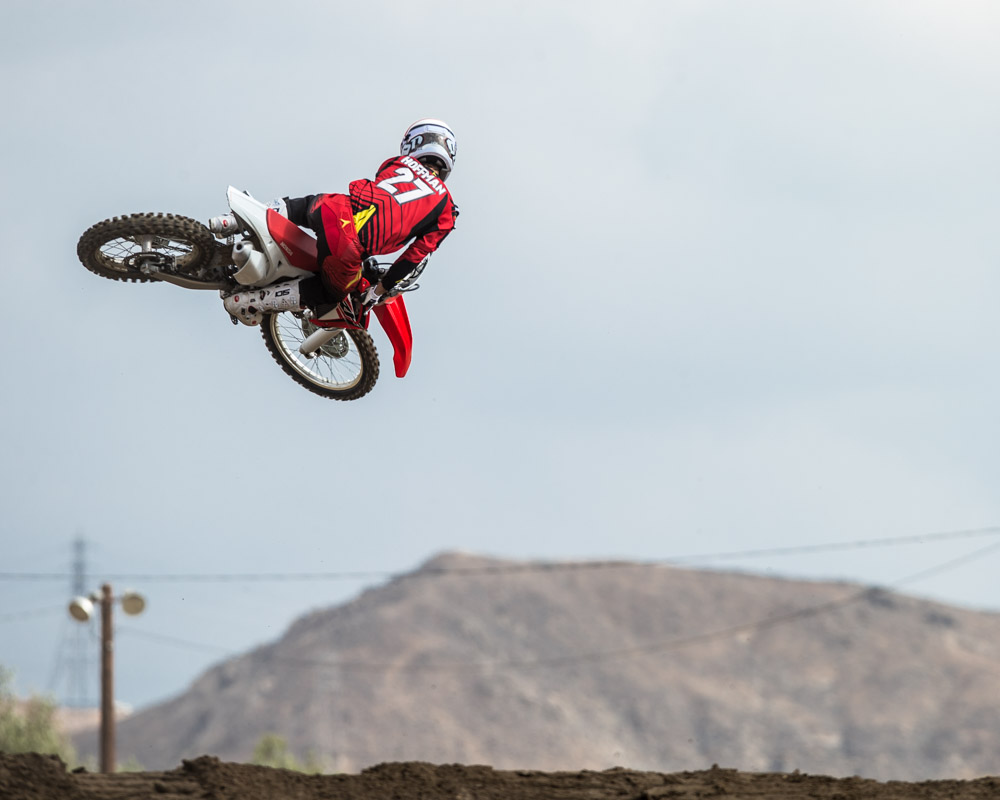

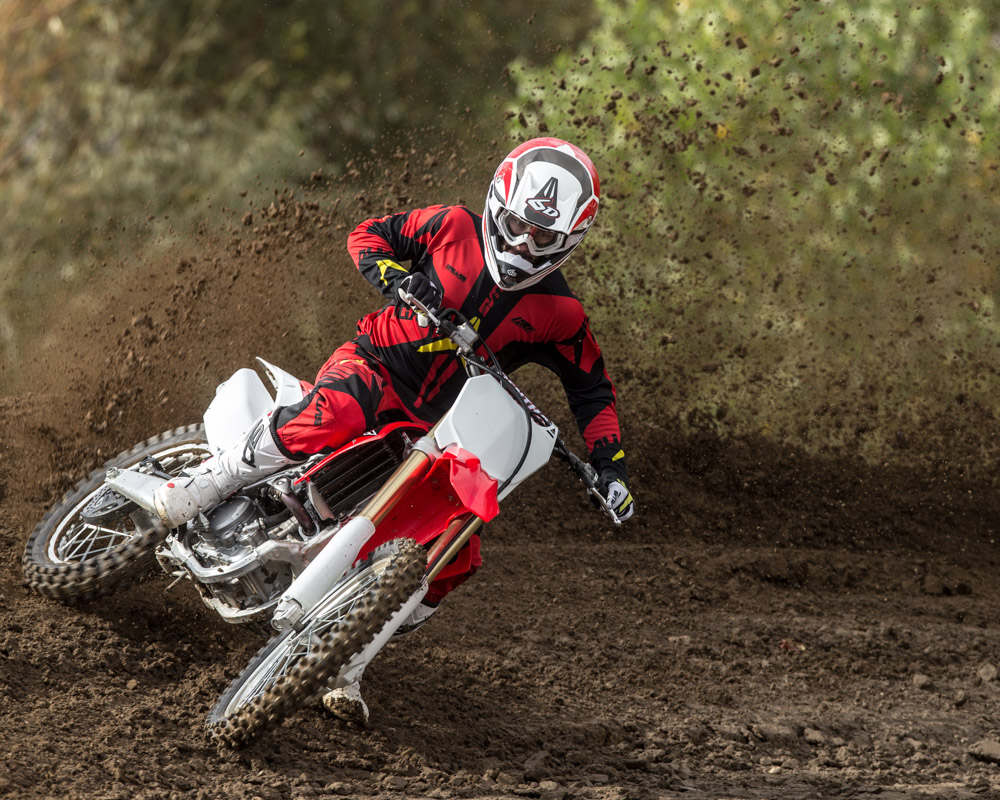
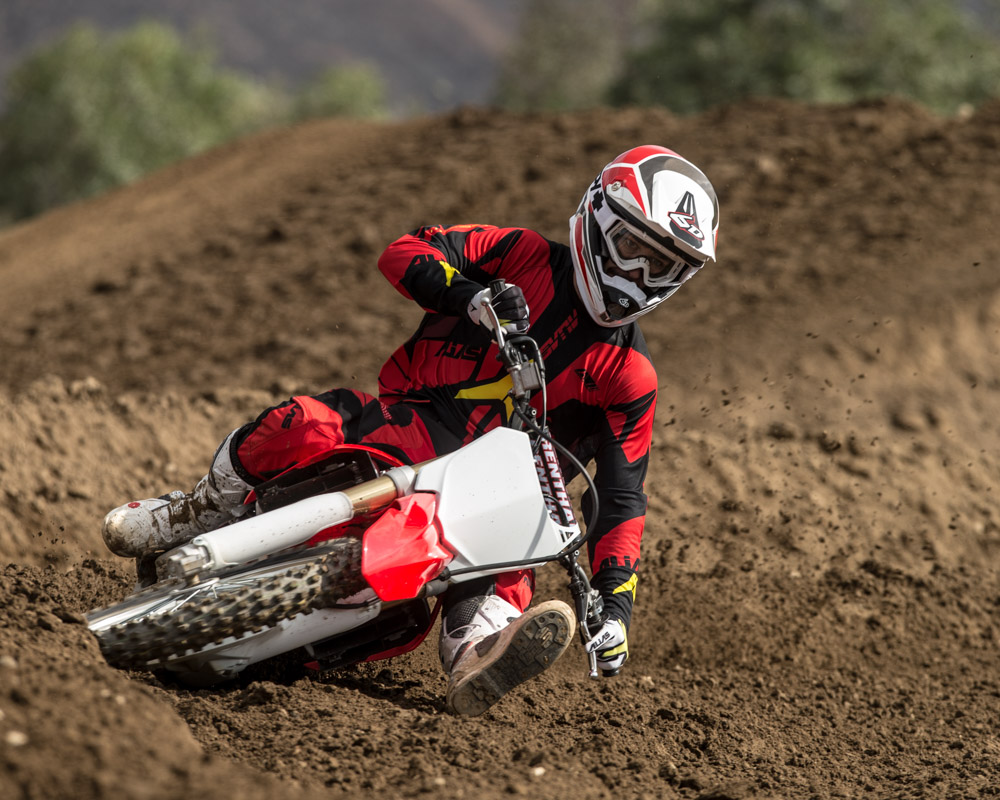
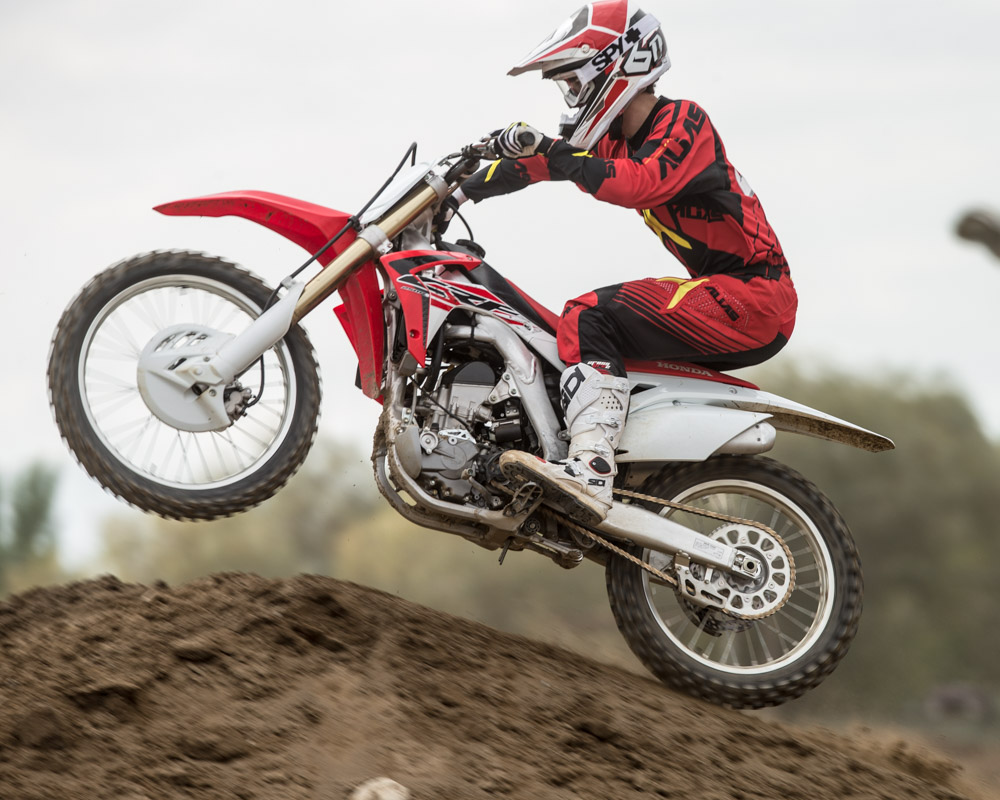
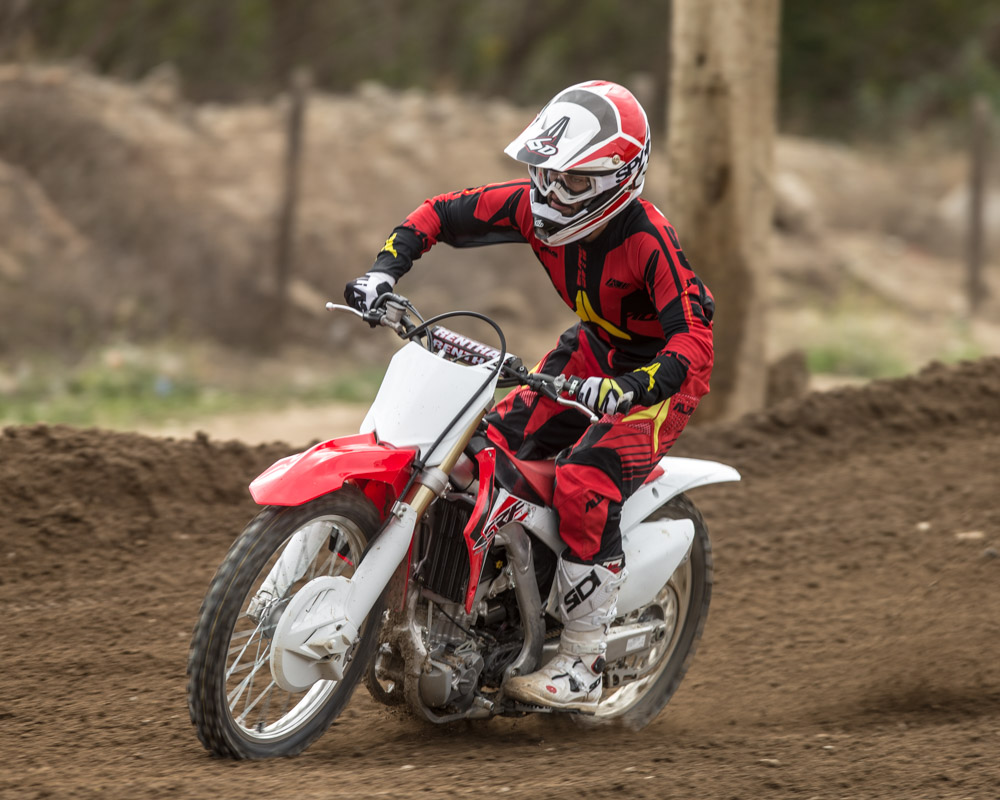
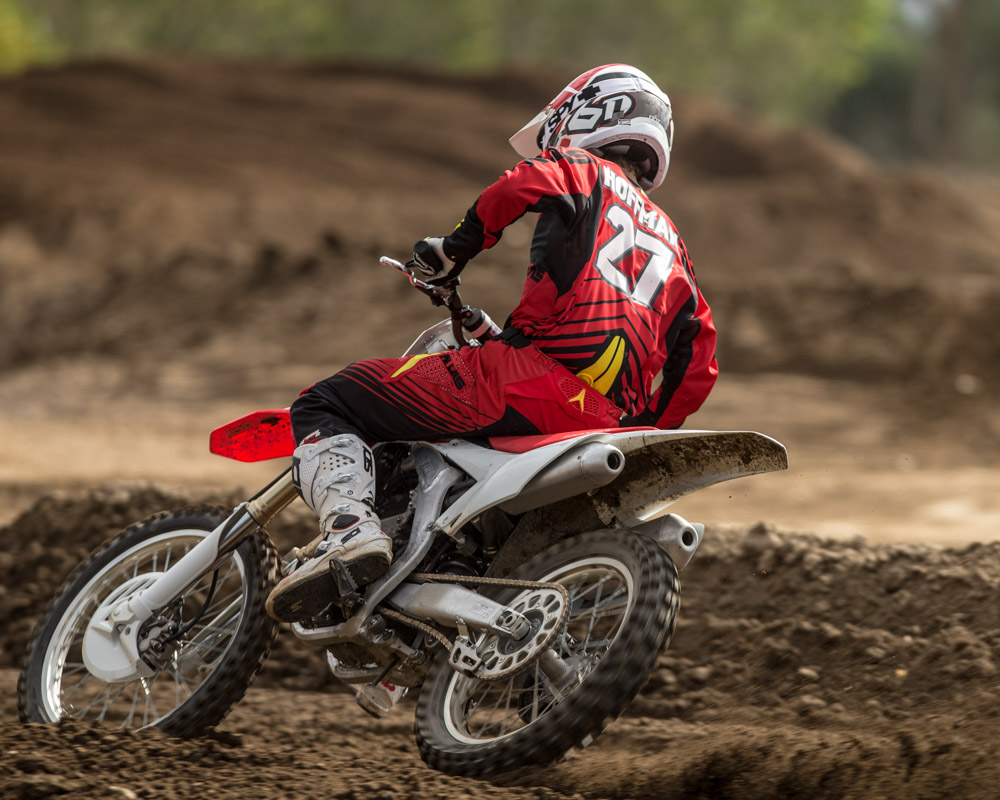
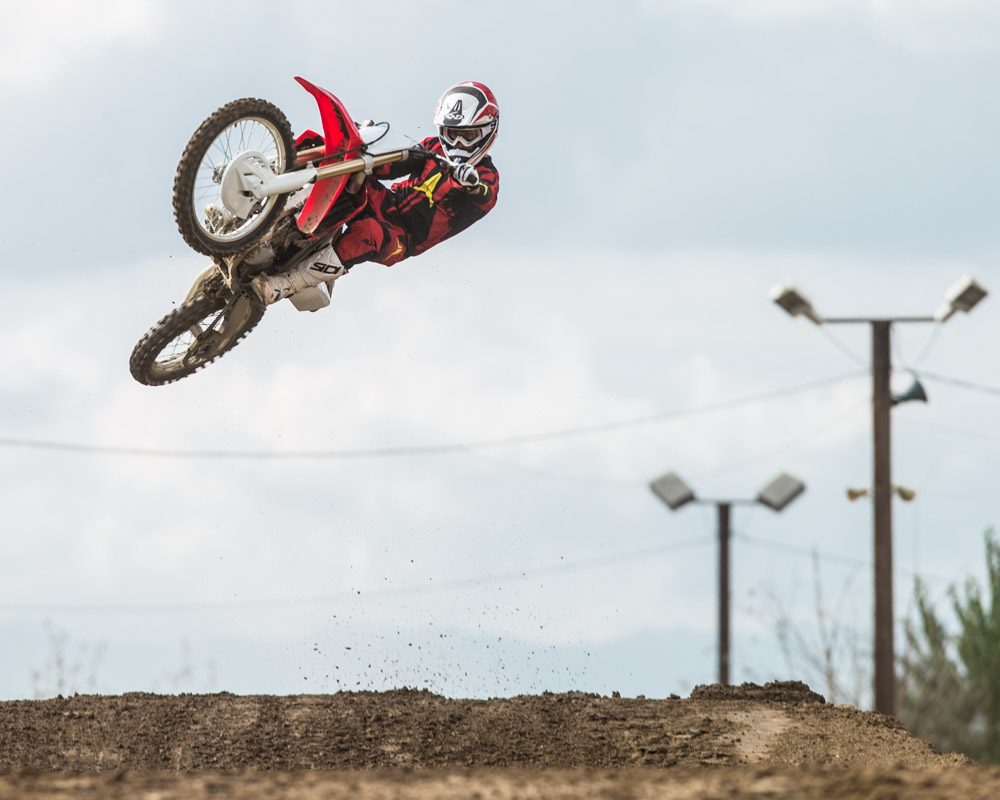

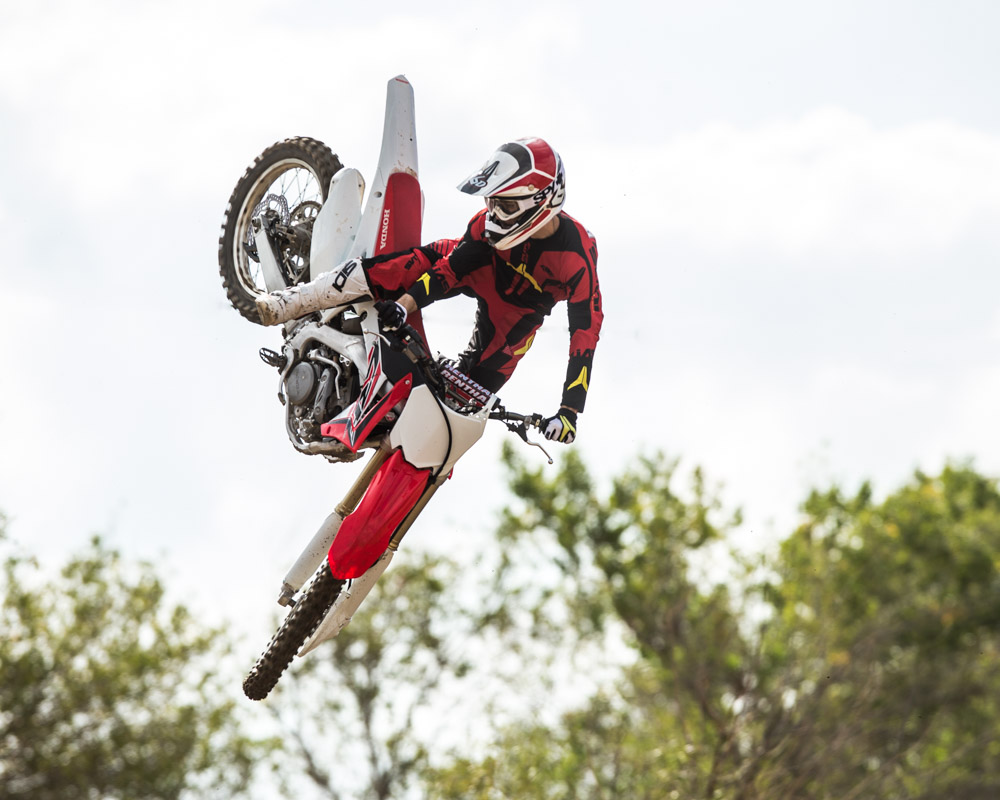
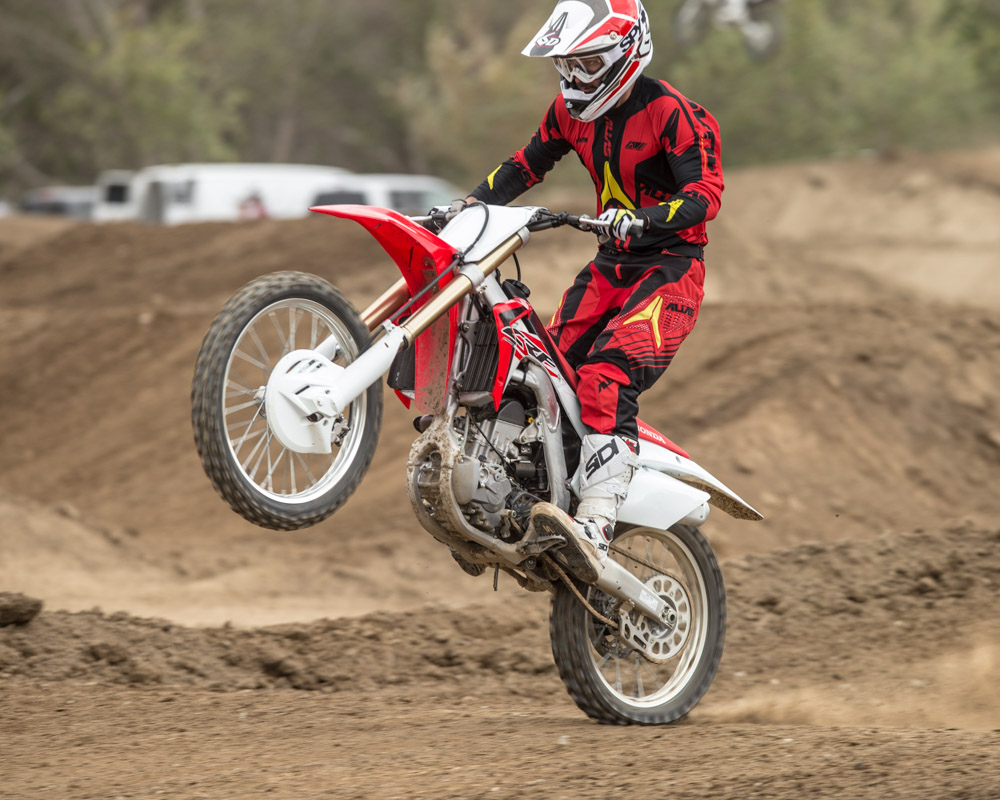
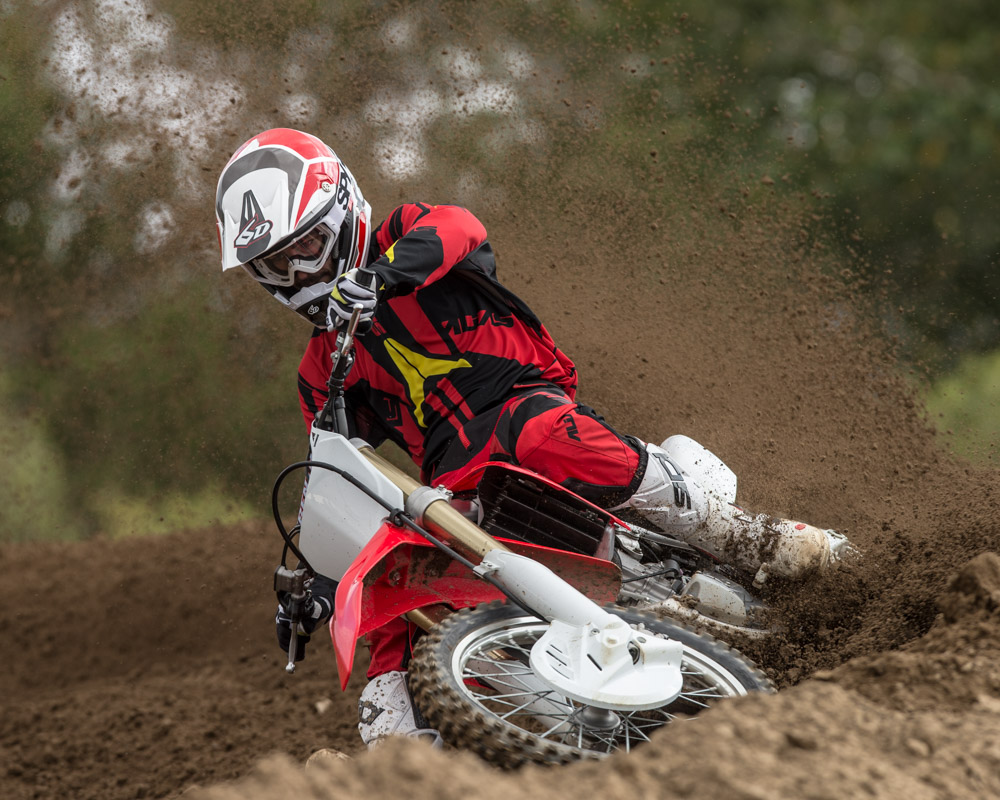
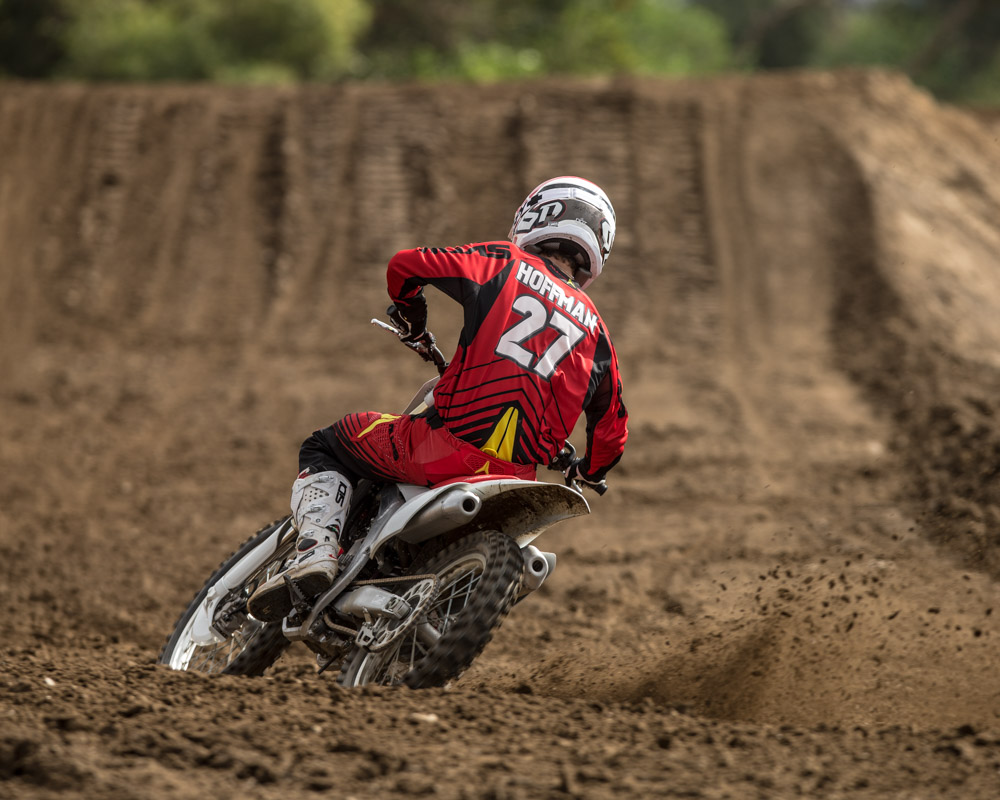
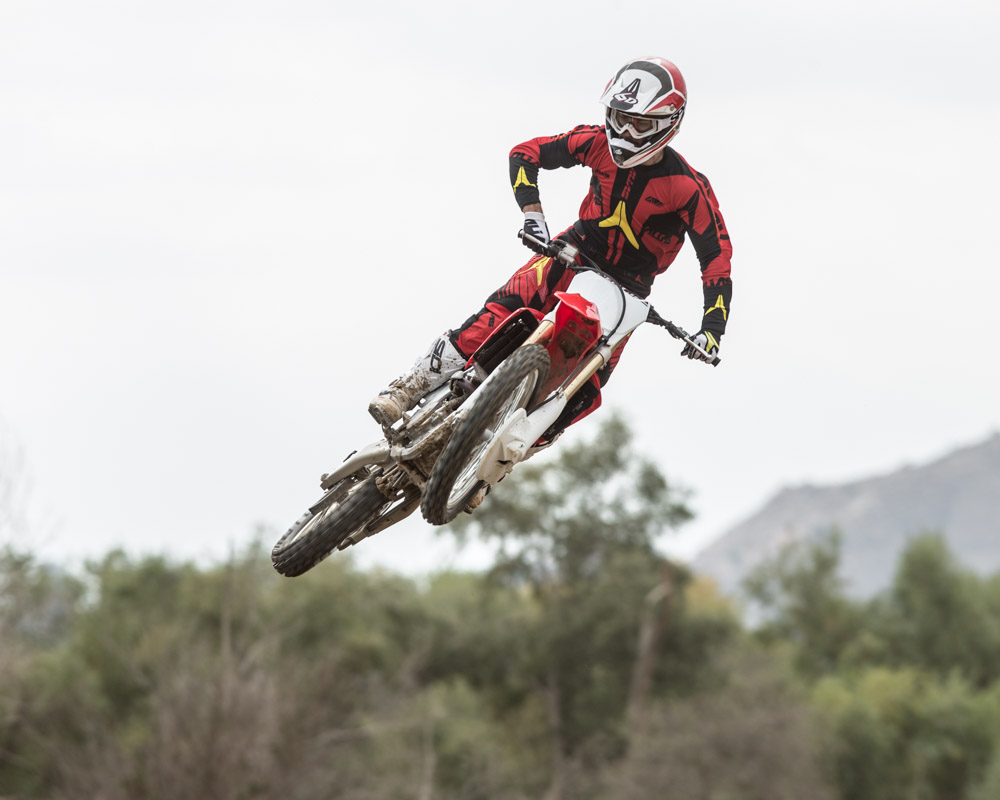
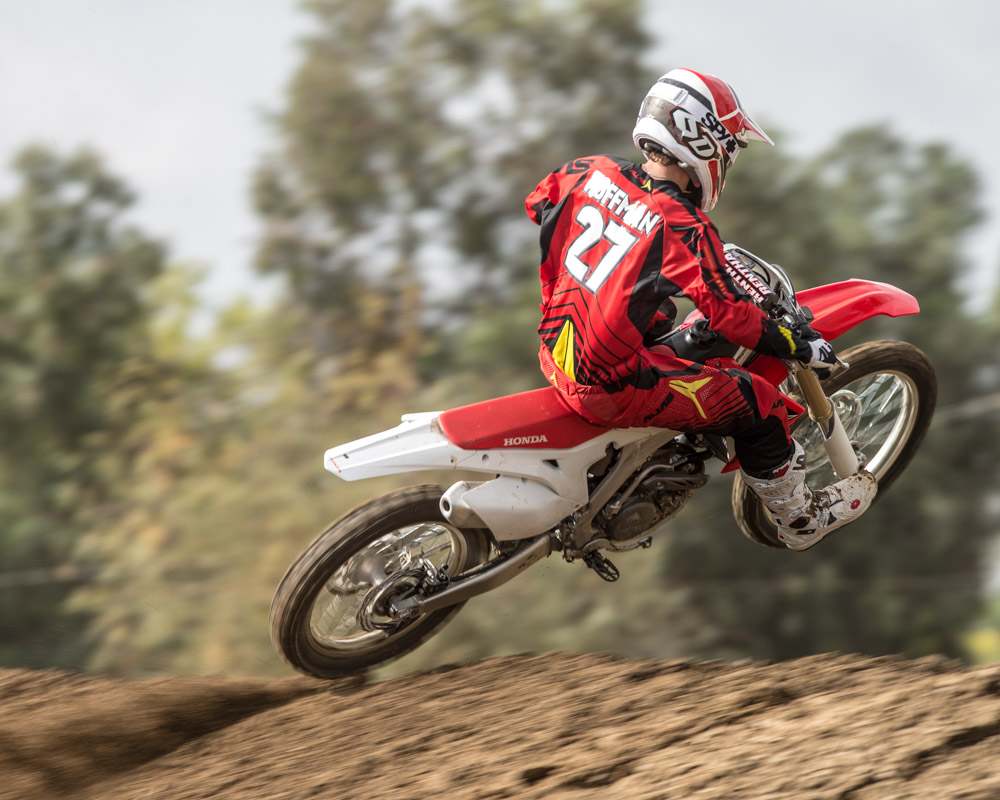
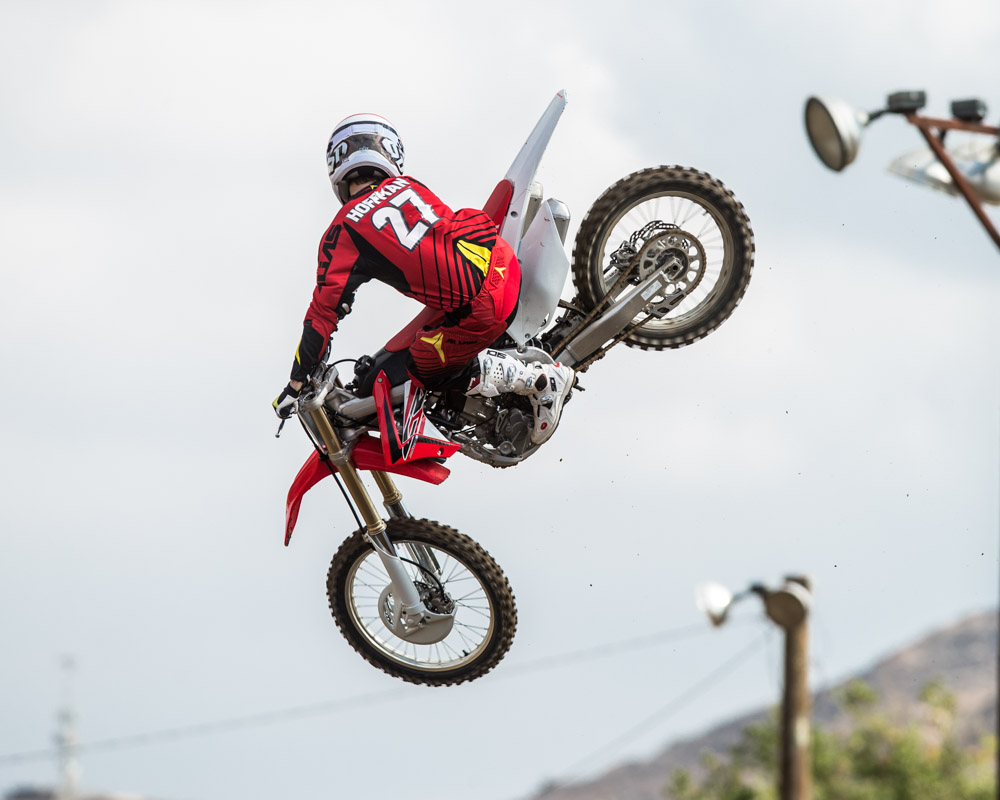
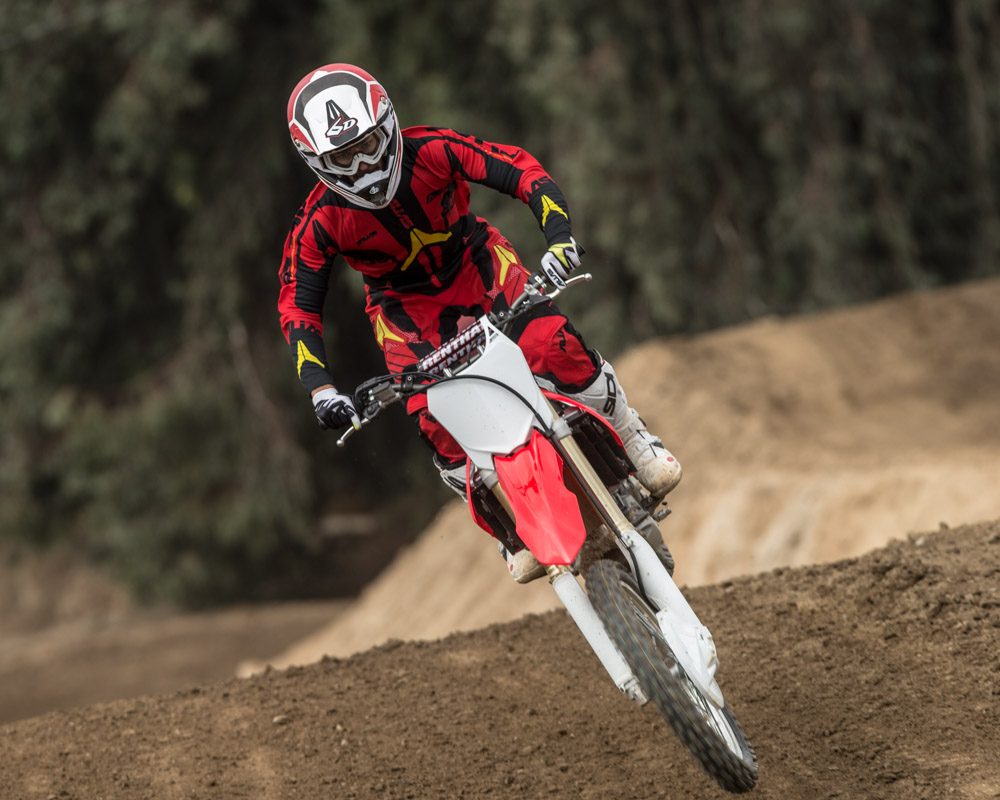

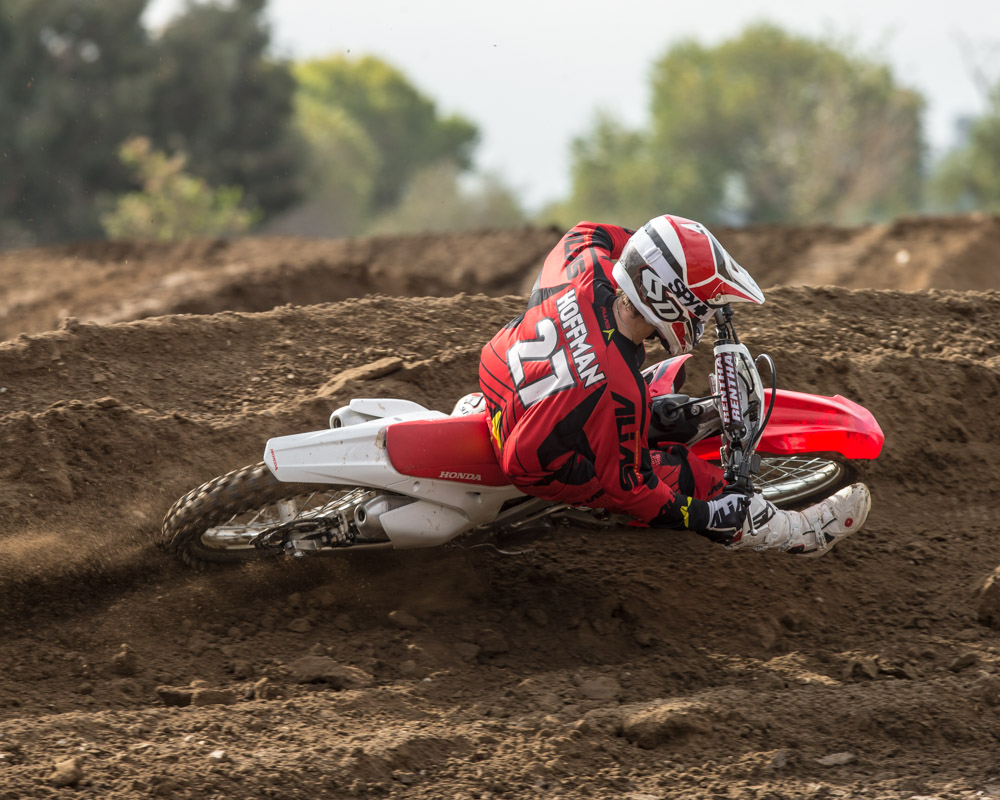


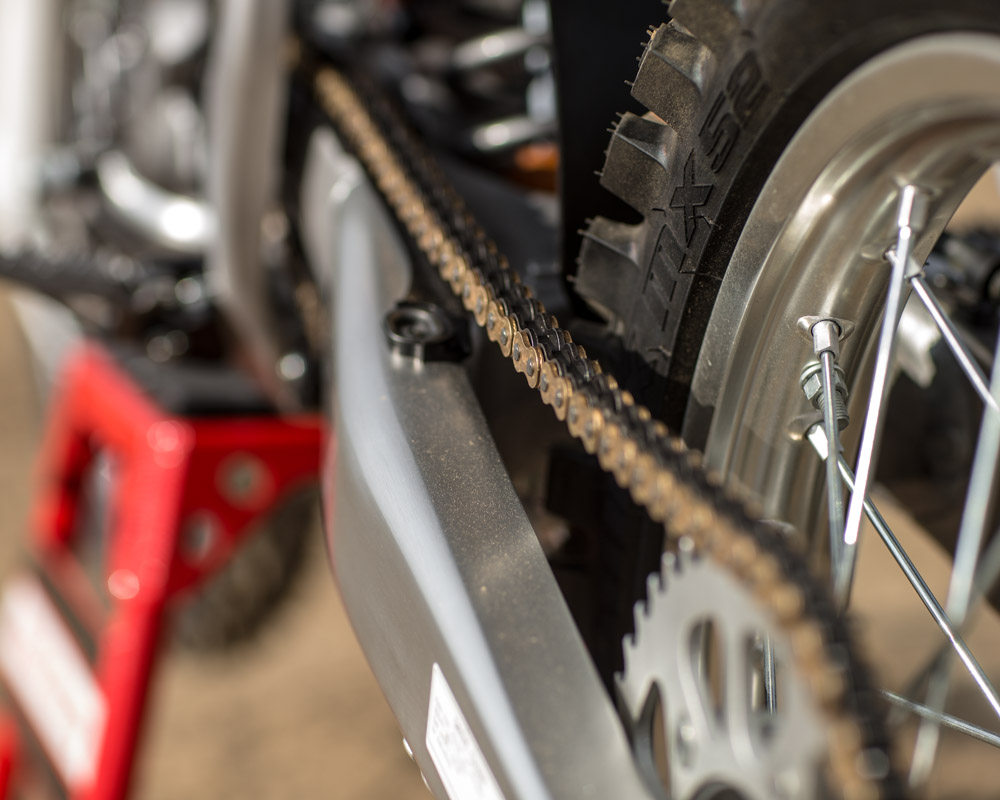
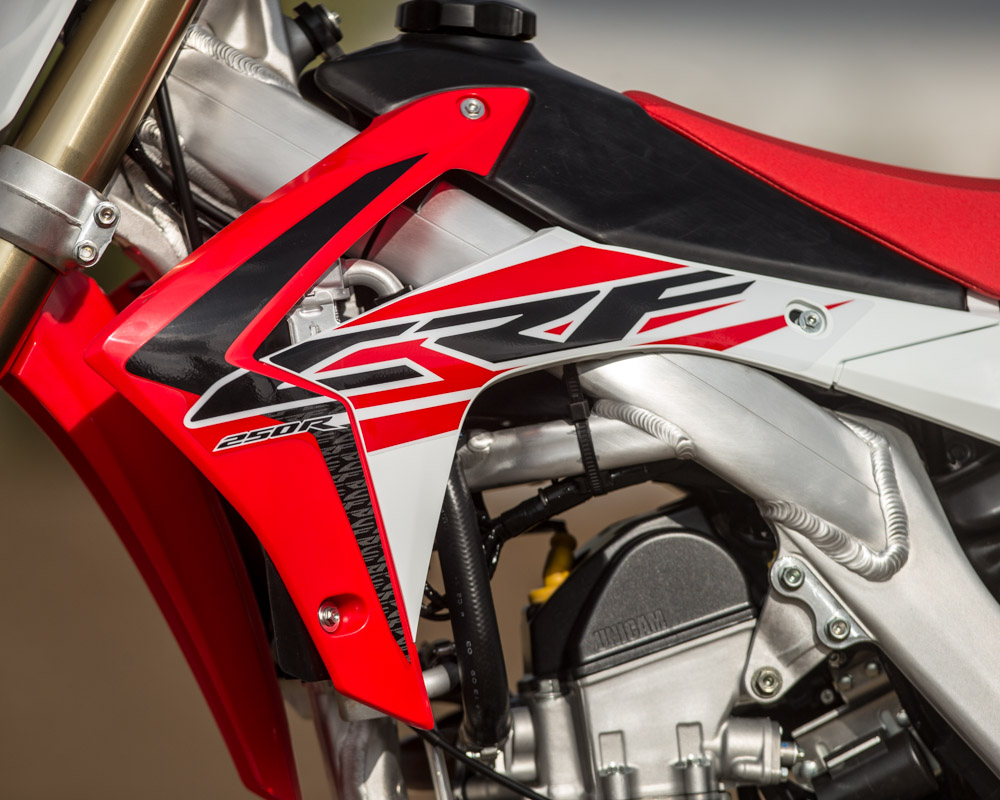
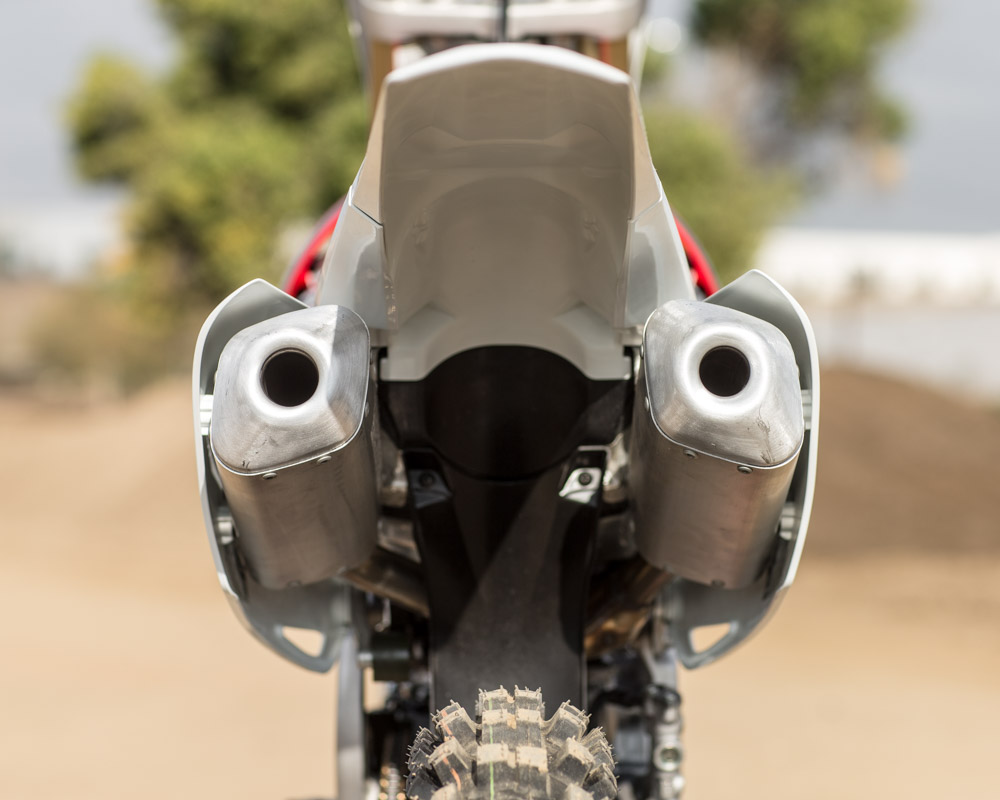
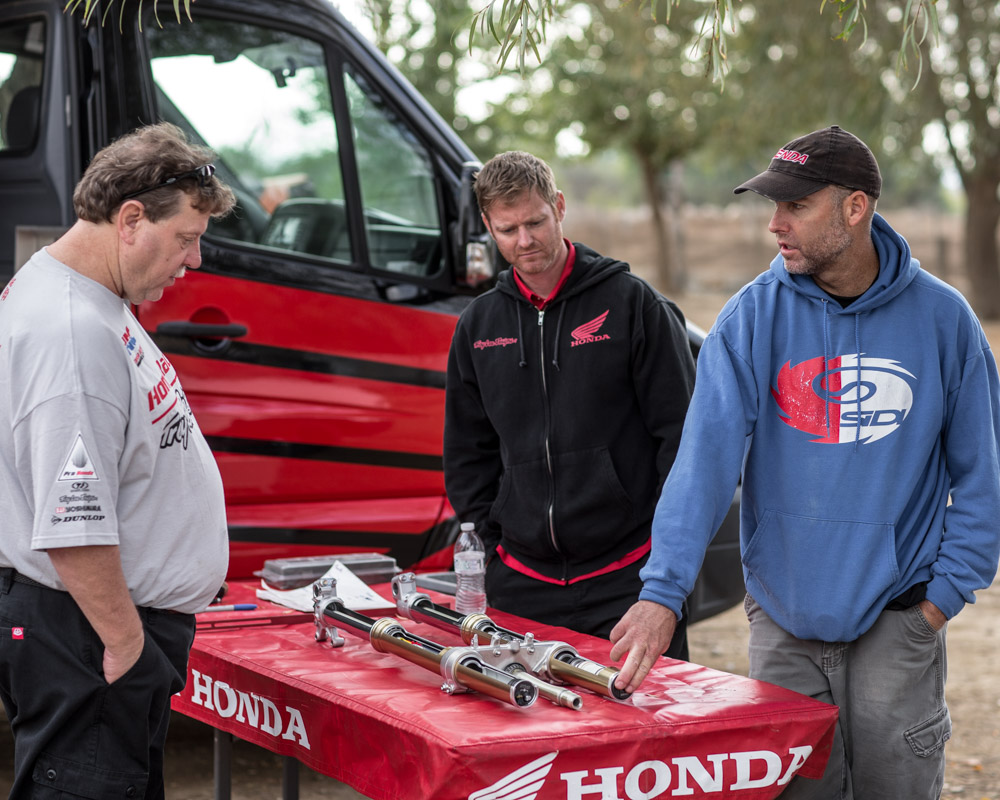
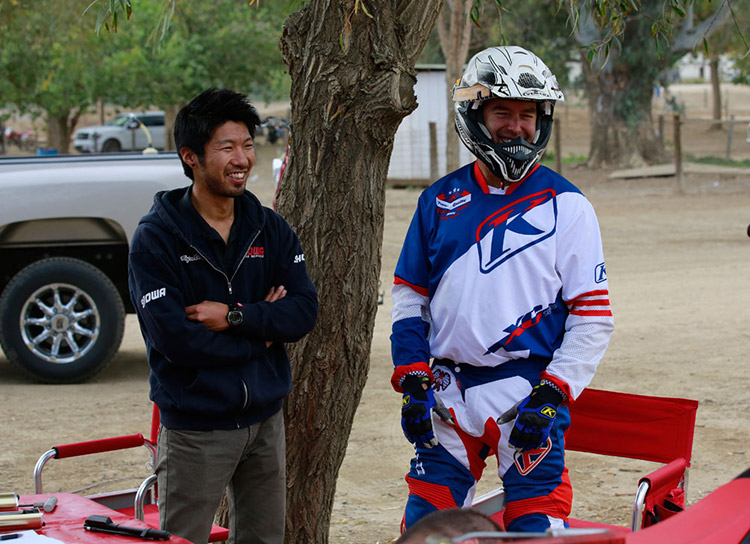
4 Responses to “2015 Honda CRF250R”
Rob
Thank you for the excellent, informative review that cuts through the popular “myths” so many publications put out there (like the slow myth). The CRF makes it’s power in a very smooth manner, one mag’s dyno test, the CRF had the highest torque reading (torque, not HP, how many people understand the difference??) and it does this at the lowest RPM. That is useful thrust in the real world.
Can you please post or email me the maps you have created? Thanks and keep up the excellent work!!
Jimmy Lewis
Maps on the way! Thanks for the support.
Jimmy Lewis
You’ll need to reach out to us through email so we can attach a file.
Jimmy Lewis
We finally got our scales in so we were able to weigh the bike before returning it to Honda. 224 lb. empty and 236 lb. with a full tank and the test is updated.